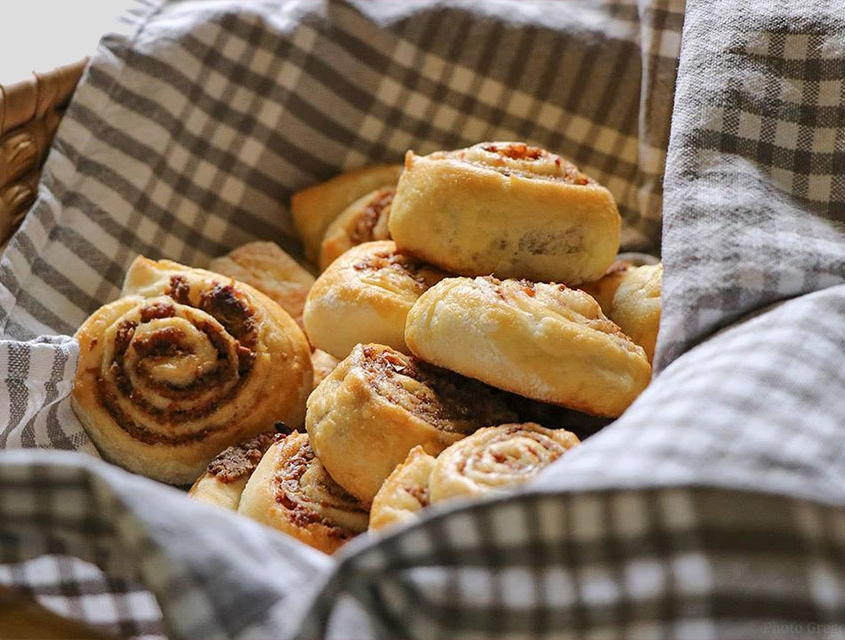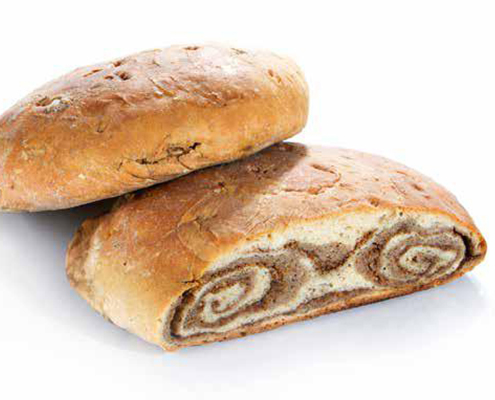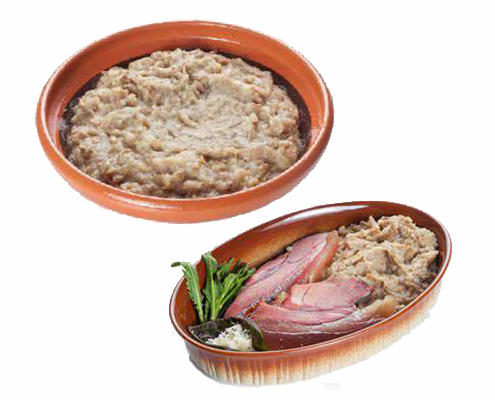Our Offer / Locally
Idrija žlikrofi
Idrija žlikrofi are potato-filled pasta in the shape of a hat, made according to a traditional recipe in the wider Idrija and Cerkno area, and prepared as an appetiser, a side dish to meat dishes, or as a stand-alone dish with meat or other sauces. A typical accompaniment to žlikrofi is ‘bakalca’ – a sauce made from lamb.
The filling, method of production and shape of the žlikrofi differ from other filled pasta dishes. The basic ingredients needed to prepare the dough for the žlikrofi are flour, eggs, and water or milk. The filling is made with potatoes, roasted onions, fat (minced lard or chopped smoked bacon), spices and herbs (marjoram, chives, black pepper, salt).
Pajtičke
Pajtičke are a smaller version of the real salty onion potica, which is typical of the Cerkno region and is considered to be the typical local potica of this region. Salty potica used to be prepared as part of lunch in the past, during mowing and other farm chores. Andrej Goljat includes the onion potica among special poticas in his monograph on poticas.
Salty little poticas with onion and walnut filling are an excellent snack. They are also tasty as side dishes to vegetable and meat dishes, replacing the bread. On festive occasions they can be served instead of other pastry.
It is no coincidence that the salty little poticas of Cerkno are in the selection of seven traditionaldishes that represent the gastronomic region of Idrija and Cerkno and help formpart of the pyramid of Slovenian gastronomy.
Smukávc
Out of resourcefulness, which was necessary, and the struggle for survival many modest dishes were created in the Cerkno region in numerous variants and combinations with fruit, vegetables, legumes, and grains. Their preparation was simple and at the beginning of the previous century still made without domestic appliances. One of the distinctive dishes of the region of Idrija and Cerkno is smukávc.
Smukávc is a dish made of various seasonal vegetables: cabbage, chicory, savoy cabbage, spinach, turnip leaves, even nettles. As a stew soup or as a side dish it makes its appearance on the table from spring to autumn and is still a common everyday dish here. We can make it thinner as a main dish (soup) or thicker as a side dish to meat.
Ajdove budle
Potica with a walnut filling often proved too expensive in the past, so it was mostly replaced by marbled bread on holidays, which was known as ajdova bùdle in the Cerkno region.
This bread, which had dough of different colors (wheat, buckwheat, and corn) to mimic the image of a festive potica, is known only to old people today. White risen dough would be kneaded for it exactly as for potica. The buckwheat flour was scalded separately. Risen yeast was added into the cooled flour. Risen white dough was rolled out and spread with a layer of dough made from buckwheat flour (ratio: 2/3 white flour, 1/3 buckwheat flour). Walnuts were sometimes added tothe buckwheat flour, maybe also walnuts and onions (the filling for the salty onion potica) for a tastier and saltier filling. The dough was rolled up as a potica.
Aleluja – turnip peels
Easter is marked by a festively laden table, but one of the oldest Slovene Easter dishes is the so-called aleluja, which is not a very well-known local dish today. Ethnologists seek its origin in the poverty most Slovenes lived in centuries ago, and in the poor harvests of the farmers. The simple dish made of dried turnip peels was first often cooked in really bad times, e.g. during the Turkish invasions, but later they also served it as a reminder of the extreme hunger, when only dried turnip peels were left to be put in the pot. Aleluja also became the first Easter dish, after which the Easter breakfast could begin. Aleluja has several regional variants.







